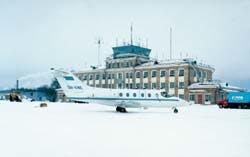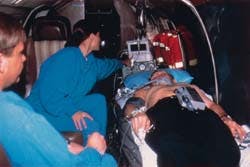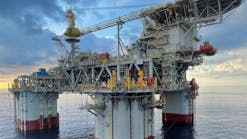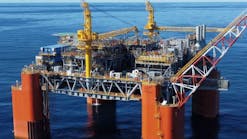Like an adventuresome tourist, the oil industry traveler often overlooks a potentially critical detail during trip preparation-the eventuality of a medical evacuation for him or her while in another country.
This oversight could at best be economically painful; at worst, life threatening.
A business traveler will generally have insurance that covers medical treatment and hospitalization in any country. But this would be of small comfort should the traveler be struck by, for example, appendicitis or suffer major injury in an automobile accident in a region with second rate medical facilities.
This includes Russia (as the accompanying article reveals), other countries in the former Soviet Union, and a dozen or so high-risk locations where the far flung oil industry is operating.
Dr. David Clyde, medical director of ARCO International Oil & Gas Co., says Americans are accustomed to the highest quality medical care in the world. Most assume it is the same everywhere. It of course isn't.
But even in some countries practicing advanced medicine, an American may find the prevailing philosophy different from that at home, which has historically paid less attention to the cost/benefit ratio of treatment than socialized European systems. There could also be a language problem, a problem in understanding.
On the other hand, expatriates in the U.S. would find U.S. medical costs staggering.
To evacuate an employee stricken by disease or trauma, ARCO, other major oil companies, and big international oil field service companies, such as Halliburton and Schlumberger, often have contracts directly with air ambulance companies for medical evacuations (medevacs).
Assistance organizations, such as International SOS Assistance Inc., provide middle man services. They are available worldwide day and night, 365 days a year. Such organizations can line up a variety of services ranging from finding local care, dispatching a physician, or arranging medevacs. The services are available to individuals on a per-trip or annual basis. This is probably the type of coverage best suited for independent travelers and expatriates.
AEA Pte. Ltd., headquartered in Singapore, also arranges air evacuations, primarily in Southeast Asia and China. But the company's major business is providing medical personnel and facilities for remote operations.
There is a sort of "do it yourself option" for a patient in less critical condition but still needing stretcher service and a doctor. Lufthansa would charge that person for five business class tickets plus a doctor's fee to get out of Russia. SAS Airlines has a similar service for about the same cost. Given the sky-high cost of air travel in Europe, even that could squeeze the limit on a typical credit card.
A medevac by a dedicated ambulance jet from just over the Urals in western Siberia to Helsinki would cost from $30,000 to $40,000 for one patient. On board medical services are extra. This flight is just over 5 hr flying time.
Given such costs, one doesn't order such medevacs for a sprained ankle. In fact, only persons designated in a preagreement have the authority to order flights for a company unless the patient's name is on a list of persons eligible for evacuation.
Helsinki
Helsinki, with its excellent hospitals and medical services, is the destination of choice for Americans and Canadians working in the Russian oil fields who need surgery or serious medical attention.
But it is some 5,600 miles (the same distance from the Rocky Mountains to Central Europe) from the Baltic across the Russian Federation to the Pacific. Evacuations from Russia's Sakhalin Island, where several oil companies are active, would be directed toward Japan. Eventually, if oil and mining activity moves into far eastern Siberia, Anchorage and Fairbanks, Alaska, would not be out of the question as medevac destinations. Of course, Russia may in time have the money to expand and improve its medical system across that vast country.
There are at least half a dozen European air ambulance companies serving Russia now. They do not depend exclusively on oil field business. Most can convert their planes for business charters and, historically, a major piece of their medevac activity has depended on European tourists. It still does.
The Diamond I jet (one stretcher) shown during a Euro-Flite evacuation from Inta in Western Siberia (Fig. 2).
Gateway
Most important for a flying evacuation service is an intimate knowledge of Russia, its people, and culture. The Finns are strong in this, having learned the hard way.
Finland gained its independence from Russia 75 years ago, then fought and single handedly won a bitter winter war with the Soviet Union in 1939. But in 1945, at the end of World War II, Finland, which had been allied with Germany, was forced to cede its province of Keralia to the Soviets and came perilously close to becoming a Soviet satellite like East Germany, Poland, and other eastern European countries. Adroit statesmanship avoided this. But the price was strict neutrality and heavy trade with the Soviet Union. Because of this trade, history, and geography, Helsinki has become the gateway to and from Russia.
Many believe it is just a matter of time before the second post-glasnost oil boom happens. Helsinki could then become-with its transportation, communications, and business infrastructure-a sort of Houston of the North.
A company already enjoying the fruits of this location is Euro-Flite Ltd., which has been flying out of Helsinki into the FSU and its former Baltic satellites for over 2 decades. A good deal of the work during the cold war consisted of flying official delegations and businessmen.
Although Russia has plenty of experienced pilots and aircraft, it does not have the medical personnel, equipment, or experience to provide medevacs. The air transport system is also somewhat disorganized because the giant state company Aeroflot was broken up into several hundred domestic companies. Even if the air system were in top shape, there is more to medevacs than flying.
Russian aviation does provide navigators for medevac flights. Without them there would be few, if any, such flights into Russia. The reasons will be covered later.
Medevacs
Records show that 120 separate ambulance flights were flown from the former Soviet Union by Western operators in 1994. Euro-Flite flew 37 of these. For the entire year 1995, the company flew 64 ambulance flights.
In 1994, the company signed long-term agreements for ambulance service with the Timan Pechora Co., a Russian joint venture of Exxon Corp., Texaco Inc., Amoco Corp., and Norway's Norsk Hydro. In addition, Euro-Flite had earlier concluded agreements with six other Western companies operating in the FSU.
The company would obviously like to see a boom in the Russian oil industry with high participation from western companies. Business charters as well as medevacs would no doubt increase.
The company has been as far as Mongolia on medevac flights. In September of last year, a Euro-Flite crew flew to a tragedy in distant Kyrgystan.
On arrival, the medevac crew learned there were no survivors in the mountain crash of a Soviet built M-18 helicopter carrying 12 passengers and a crew of three. The passengers, mostly Canadians, worked for a Canadian gold mining company with interests in the central Asian republic.
Fig. 1 [57092 bytes] shows the cabin configuration of Euro-Flite's Falcon 20 jet for this trip. A smaller company jet has one stretcher (see Figs. 2 and 4).
The passenger seats in this configuration are occupied by a physician and nurse. Euro-Flite has a working arrangement with Helsinki's EMA Group Ltd. The Euro-Flite crew is responsible for the flight, while the EMA professionals deal with the patient.
Calls for evacuation are directed via phone or fax to around-the-clock duty operators at either Euro-Flite or EMA. The operators pass on the information to an EMA physician who contacts the calling party to get more information on the patient's condition and then starts the preparations for an evacuation. Both EMA and Euro-Flite stress that it is extremely important that prior agreements for evacuation service have been set up with them or through an international assistance company.
At this time, Euro-Flite begins flight preparations, including a flight plan, confirms weather conditions and alternative airports, and determines availability of a Russian navigator. Based on the patient's condition, the EMA coordinator sees that all necessary instruments and medicines get on the plane. He or she also plans treatment during the flight. Typically, according to EMA and Euro-Flite, the aircraft with medical team is ready to take off from Helsinki 2 hr after getting the call for assistance.
Inside Russia
Flying such missions in Russia today can be complex and suspenseful. Juhanni Missonen, managing director of Euro-Flite, says each flight into Russia requires a separate permit from the Moscow-based Central Department of Operational Services. The system operates well for ambulance flights, he says.
Missonen says that out of an estimated 1,000 airports in the FSU, only 400 can be used by jets and only 73 of these have published approach charts. Only 43 are "airports of entry," offering customs, passport control, and English-speaking air traffic control.
Russian navigators are the solution to landing at these formerly unknown airports, which were once military secrets, as was most everything else in the Soviet Union.
Euro-Flite's senior captain, Matti Siimes, who has logged hundreds of hours of flying over the Former Soviet Union, says the company's jets all have advanced navigating gear and don't need the Russians to guide them. They are needed because they can talk to the flight controllers in Russian and because they have the all-important airport approach charts and maps.
Siimes, who was once an Alaskan bush pilot and who still flies his own seaplane around Finland on holidays, says the Russian navigators are ready and willing to work and highly competent. They earn $450/day plus expenses.
Siimes and other company pilots pick up their Russian navigators (with their charts and maps) at St. Petersburg, one of Russia's airports of entry. Customs and immigration are also cleared there. Practically all of Euro-Flite's trips to Siberia go through St. Petersburg. The official business here generally takes from 30 min to 1 hr. However, when the destination is Moscow, the company can fly directly there without a navigator.
After takeoff from the former Leningrad, a variety of minor and major problems can crop up, even with the Russian navigator onboard. The pilots can leave their credit cards and checkbooks at home because essentially all airport transactions are handled in cash, primarily U.S. dollars. They must be clean-looking dollars issued since 1993.
The Russians are being burned with counterfeit dollars. As a result, Siimes says the pilots must take a lot more cash than is needed. The reason is that the Russians are using counterfeit bill detectors that are set so sensitively they often reject good money, which the Russians won't take.
Landing fees in Russia are quite high, Missonen says, running $700 to $1,000/landing. Jet fuel costs from 95 to $1.40/gal. There are sometimes problems in getting the fuel but the dollars have a way of making it appear. One source tells the Journal that an airport manager has taken jet fuel from parked planes to refuel another that wanted to leave.
As a result of this cash system, pilots must carry large sums, amounts that are fortunes in Russia's chaotic economy. This has made the pilots targets for the many lawless or desperate elements in present day Russia. A solution to this has been to hire body guards in Helsinki to accompany medevac and charter flights. These are well-trained professionals licensed to carry weapons in the FSU (OGJ, Aug. 29, 1994, p. 19).
EMA physician Leena Mildh and paramedic Harri Bckman monitor a patient's condition while in flight. The patient is on a respirator (Fig. 4).
Typical flight
Fig. 3 [100132 bytes] illustrates a flight to Siberia based on a Euro-Flite aircraft's logbook. Kogalym is in an oil drilling area in Western Siberia. Total time from takeoff to return landing in Helsinki was 12 hr and 50 min. The flight from Kogalym to Helsinki required only 6 hr including a 20 min stop for refueling in Syktyvkar, the capital of the Komi Republic, and another in St. Petersburg.
Delays can appear at the destination if the physician has to go to a local hospital to get the patient or if the patient is at a field location not near the airport.
Not all medevacs go to Helsinki. Euro-Flite transported a patient from Orenburg to London. It took 8 hr and 14 min for the patient to get from Orenburg to London. The trip entailed stops in Moscow and Copenhagen for refueling.
Physician on board
Having critical care physicians and nurses on board is the ultimate in medevac service (Fig. 4 and cover picture). Another school of thought, however, believes a highly trained paramedic is sufficient. This is of, course, a less expensive alternative. The basic fee for an evacuation with physician and nurse is $1,200/case. An additional fee of $90/hr is charged for the physician, $65/hr for the nurse, plus any travel or lodging expenses.
Dr. Ari Kinnunen, managing director of EMA Ltd., makes a case for the physician-assisted service. Around the clock coordinators and physicians at the company's Helsinki headquarters can establish quickly the patient's condition and needs.
This information starts an important phase in the mission-selection of all medical equipment, instruments, and drugs necessary to treat the patient during the flight. Generally, because the equipment is small and battery powered, everything needed fits into two suitcase-sized bags. The kits contain such items as respirators, defillabrators, 12-lead electro cardiogram (EKG) units, syringe infusion pumps for intravenous medication, and temperature, blood oxygen, and carbon dioxide monitors. If necessary, a sufficient number of liter-sized bottles of oxygen can be carried as well as whole blood for transfusions.
The kits also contain medications, oral and intravenous, for all normal cases. The intravenous kit contains 42 different medicines in ampules.
This flexible approach is superior to having an ambulance plane with equipment built in, Kinnunen says. Also, he points out, the patient can be hours from the airport. This would require transport by vehicle or helicopter, situations where portability of instruments could be critical.
"If an unusual case occurs, which we will know about because we have a physician coordinating the mission, we'll pack medication and equipment for that too," Kinnunen says.
"In short, we can deliver high-quality intensive care to the patient on the ground or in the air."
Kinnunen also stresses emergency care experience and continual training, as does everyone involved in critical first care. EMA with its ten specialized physicians also provides the Helsinki region with life flight helicopter service. More than 1,600 flights per year are flown, almost always to assist severely injured or sick persons. Some 15% die during the flights.
This experience gives the professionals concentrated and continual experiences in emergency treatment, Kinnunen says. They would lose this expertise flying only the less frequent medevac flights.
Copyright 1996 Oil & Gas Journal. All Rights Reserved.




